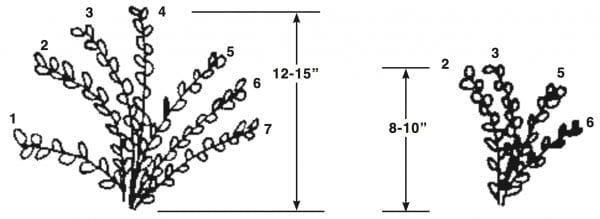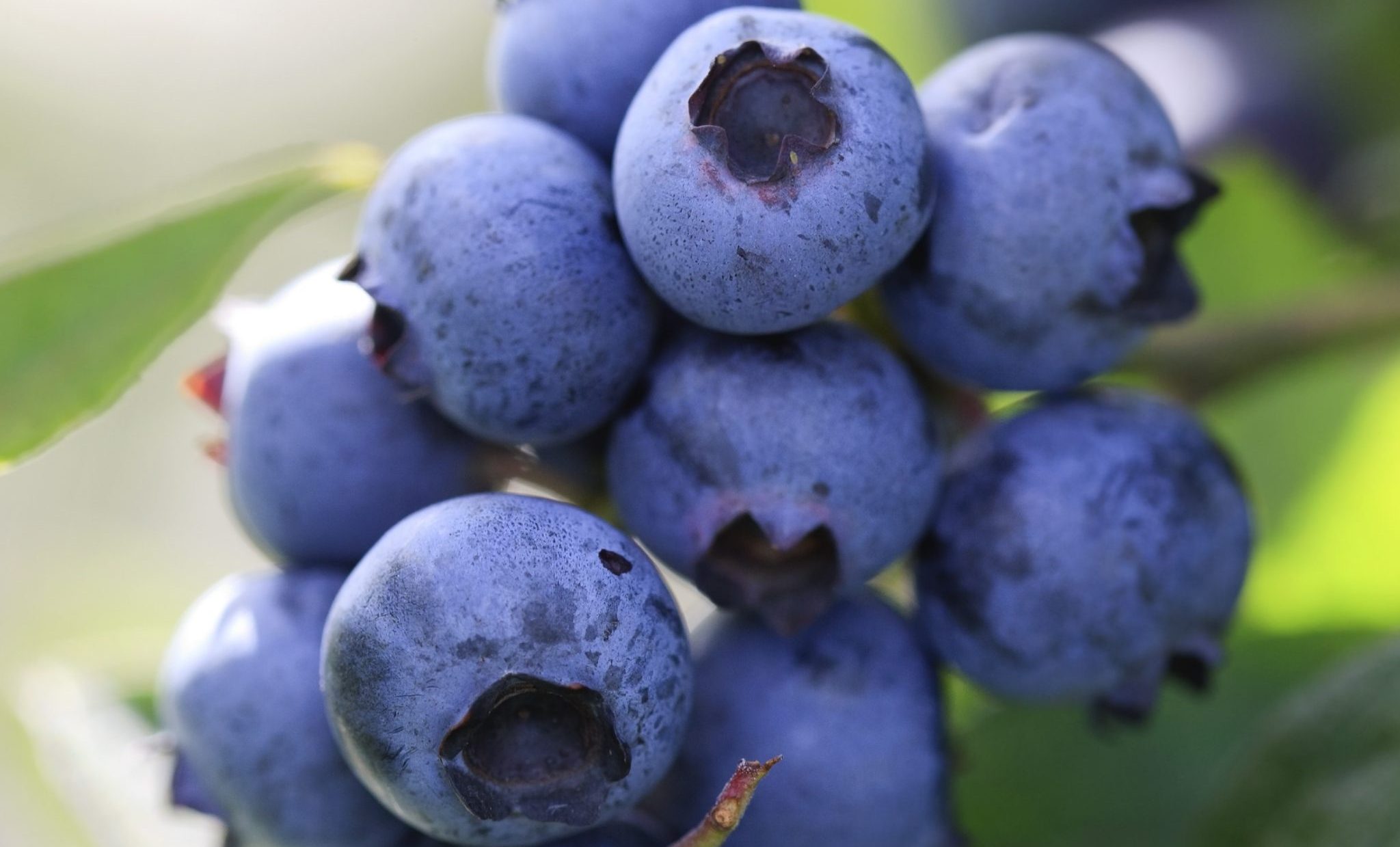Fruits

Learn the guidelines for site selection, soil preparation, and planting of rabbiteye blueberries, along with watering, fertilizing, pruning, harvesting, and storage. Included is a table of the most popular varieties, according to fruiting season, plus recommendations for necessary cross-pollination of this beautiful and bountiful plant.
Rabbiteye blueberries are one of the most delicious fruits grown in the South. They are also one of the easiest fruit plantings to grow. The plant is prized for its ornamental value of spring flowers and fall colors and is often used for edible landscapes in home gardens.
The rabbiteye blueberry, Vaccinium ashei, is native to the southeastern United States. This species is tolerant of the heat and drought of the South and grows wild in southern Georgia, Alabama, and the Florida panhandle.
Selecting Varieties
One of the most important growing requirements of blueberries is their need for cross-pollination to set fruit. You will need to plant more than one variety for cross- pollination to occur.
Rabbiteye blueberries have their own special pollinators. The carpenter bee and blueberry bee almost exclusively forage in blueberry flowers during bloom time. Honey bees are usually not as efficient in pollinating but certain other solitary bees are quite effective.
By selecting several varieties, you can spread out the length of your harvest time. Blueberries do not ripen all at once. One variety may have berries that mature over a 4- to 6-week period. Here are some of the most popular rabbiteye blueberries available in nurseries today, listed by fruiting season.
Table 1. Blueberry Cultivars
| Early Season | Mid Season | Late Season |
|---|---|---|
| Alapaha | Powderblue | Ochlockonee |
| Climax | Yadkin | Onslow |
| Premier | Tifblue | |
| Titan | Pink Lemonade | |
| Krewer | ||
| Vernon |
Selecting a Site and Preparing the Soil
If you want your blueberry planting to produce a lot of fruit, select a site that is in full sun with well-aerated, well-drained soil high in organic matter.
Blueberries need acidic soil with a pH between 4.5 to 5.2 (Take a soil sample before planting blueberries). If you are planting blueberries as a landscape shrub, combine them with other plants that thrive in acidic soil, such as azaleas, rhododendrons, and camellias.
The Alabama bloom time for many blueberries is also when late-season frost and freezes can occur. So plant blueberries in a protected site to avoid damage to the flower buds. Plant blueberries away from frost pockets— low areas and sites that do not have good air movement. You usually can’t do much to protect tender blooms from late-season freezes, although newer approaches, including covers, are being evaluated. When selecting a suitable planting site, remember that cold air and frost flow downward.
Planting
The best time to plant blueberries is in late fall through late winter.
Space the plants at least 5 feet apart in a row. This spacing will result in a hedgerow or border as the plants mature. If you plant several rows of blueberries, space the rows at least 10 to 12 feet apart.
Plant blueberries at the same depth they were grown in their containers. Do not pile soil up on the base of the trunk.
When planting an individual plant, make the hole at least twice as wide as the rootball. Amend the soil in the planting hole or row with some form of organic matter to raise the root ball (compost is best, but finely ground pine bark is satisfactory). Thoroughly incorporate or mix organic matter into the planting hole. Untangle circling roots if noticed after removing the container.
Watering
Water is one of the most important needs in establishing and maintaining productive blueberries, particularly during their first year of growth. You should water plants thoroughly at planting and twice weekly for the first year until they are established. Water plants for a longer time once or twice per week, rather than for a short time each day. This will promote better root establishment.
Because blueberry plants have the ability to retract water from berries, adequate moisture, particularly during fruit production, is essential to producing plump, juicy berries. Blueberries set next year’s buds in the late summer and early fall. The plants must receive adequate moisture for plant growth and bud development during this period.
Place drip irrigation or soaker hoses underneath several inches of mulch, such as chopped leaves, pine needles, or other organic mulch. Mulch keeps plant roots cool and moist and helps suppress weeds.
Fertilizing
You do not need to fertilize at planting; in fact, it’s important not to overfertilize blueberries at any time. For best results, a soil test indicates if (and how much) limestone or fertilizer is needed in your soil for optimum plant health and production. Get information for soil tests at your county Extension office.
A slow-release fertilizer that has sulfur-coated urea, such as 12-4-1, works well. Follow product label directions or use about 1 ounce of 12-4-1 per plant per year of age (not to exceed 6 ounces in the spring, or 5 ounces on postharvest applications). An organic fertilizer such as cottonseed meal (6-3-2) could be used.
Apply fertilizer twice a year. When spring growth begins, apply a 12-4-1 formula or cottonseed meal in two applications—when growth begins (March/April) and again in June (2 ounces per plant per application). Do not use nitrate forms of fertilizer for blueberries as this will cause root damage.
Pruning

Figure 1. A two-year-old blueberry plant before pruning (left) and after (right). Branches 1, 4, and 7 have been removed and branches 2, 3, 5, and 6 have been tipped.
While blueberry plants need less pruning than many other fruit plants, pruning is still important. Pruning induces new growth and larger fruit. Blueberries produce fruit on the growth from the previous season (1-year-old wood). Older, woody canes (stems) produce smaller, poorer quality fruit. Younger canes produce larger, higher-quality fruit.
Pruning is important to maintain plant vigor. Blueberry plants can put on a lot of new growth each year when pruned correctly.
Pruning opens up the plant for greater sunlight penetration to the foliage. This improves fruit size and set, and further enhances color development and taste.
Reasons for pruning blueberries include the following:
- To stimulate new growth and plant vigor
- To provide shape or form to plants, especially when used as landscape shrubs
- To remove dead or diseased wood
- To reduce fruit load to make berries larger
- To keep plants a manageable size for harvesting
- To provide air movement inside the canopy to reduce disease problems
After planting, remove about 1⁄3 of the height of the plant and any branches that cross back toward the center of the plant. During the first growing season, remove fruit buds so that the plant will use nutrients and water to develop shoots and roots, not fruit.
Maintain new growth on 2-year and older plants by removing any lower, prostrate-growing branches and any weak, diseased, or damaged wood before plants begin growing in the spring. You may also need to prune each year after harvest. For example, you can prune about 1⁄3 of the length of tall shoots so that they will support the fruit produced next year.
When plants reach a mature size (8 to 10 years old), you’ll need to remove some of the old canes each year so they can be replaced with new growth. This is called renewal pruning, and it helps to keep the plants healthy and productive. Severe renewal pruning, which reduces the height of plants to 5 feet or less, should only be done every few years.
Controlling Weeds, Diseases, and Insects
If you notice a pest attack on your blueberry bushes, call your county Extension agent for pest control recommendations.
Harvesting and Storage
Blueberries are easy to pick. To freeze blueberries, spread them out and let the berries dry. Store in plastic containers or freezer bags after harvesting. This keeps berries from sticking together. You can remove berries from the freezer and wash them before using.
 Elina Coneva, Extension Specialist and Professor, Commercial Horticulture at Auburn University
Elina Coneva, Extension Specialist and Professor, Commercial Horticulture at Auburn University
Revised July 2021, Home Gardening: Rabbiteye Blueberries, ANR-1078

